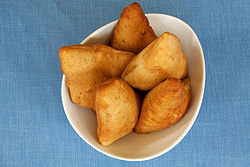




South Sudanese cuisine is based on grains (maize, sorghum). It uses yams, potatoes, vegetables, legumes (beans, lentil, peanuts), meat (goat, mutton, chicken and fish near the rivers and lakes), okra and fruit as well. Meat is boiled, grilled or dried. [1]
Contents
South Sudanese cuisine was influenced by Arab cuisine. [2]